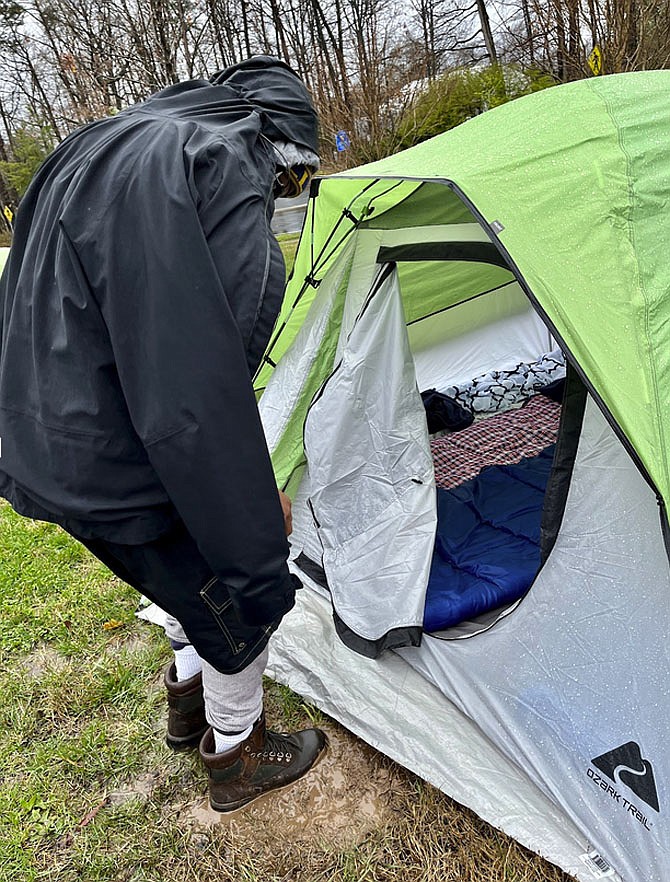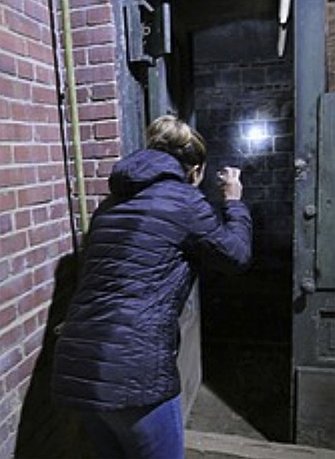Experiencing homelessness in the rain, Fairfax County Photo by Mercia Hobson.
The current U.S. Department of Housing & Urban Development (HUD) Point-in-Time Count (PIT), a snapshot of people experiencing actual homelessness on one day, has limitations. Nationwide, including in Fairfax and Arlington counties and the City of Alexandria, challenges with the annual HUD-administered PIT in January underestimate the extent of the crisis, especially for unsheltered homeless people.
The National Homeless Law Center says in a report the true scale of homelessness falls between 2.5 and 10.2 times what the PIT count suggests. To count people experiencing homelessness, volunteers from local organizations and staff must have their eyes on them, according to HUD.
Unsheltered homeless people often become invisible and are undercounted. They can be transient and opt to sleep in areas “not designed for human habitation,” wooded areas, cars, parks, campgrounds, abandoned buildings, for example. They might risk violating codes but are unwilling to enter a shelter. Shelters can cause concerns about their health and safety. They desire autonomy and privacy and, from past experiences, may harbor a protective distrust of the system.
But first and foremost, unsheltered homeless people opt to sleep in areas not designated for human habitation because of a lack of affordable housing, especially for those whose income is below 30 percent of the Area Median Income. They struggle to find affordable and available units for which they qualify.
HUD Funding to Serve the Homeless Is Data-Driven
To better understand homelessness, HUD mandates the Point In Time count “to serve the homeless population through its Continuum of Care program.”
The Point-in-Time (PIT) Count is a count of sheltered and unsheltered people experiencing homelessness on a single night in January. HUD requires that CoCs conduct an annual count of people experiencing homelessness who are sheltered in emergency shelter, transitional housing, and Safe Havens on a single night. CoCs also must conduct a count of unsheltered people experiencing homelessness every other year (odd numbered years). Each count is planned, coordinated, and carried out locally.
The PIT Count offers insight on unsheltered homelessness in local jurisdictions. It helps determine the need for housing and supportive services and the level of awards from HUD. According to HUD, the Continuum of Care is “a community plan to organize and deliver housing and services to meet the specific needs of people who are homeless as they move to stable housing and maximize self-sufficiency. It includes action steps to end homelessness and prevent a return to homelessness.”
In 2023, HUD announced $3.2 billion in CoC Competition Awards for thousands of local homeless service and housing programs across the United States. Locally, for example, Arlington County’s Pathforward, Inc. Turning Keys received $683,202 from HUD in 2023 to provide direct services to homeless people in their communities, according to the FY 2023 CoC Awards.
The National Law Center on Homelessness and Poverty asserts that one must see people to count them. Current PIT methodologies miss some unsheltered people who sleep in areas not visible on the night of the count. People who shift from one locality to another to evade laws that criminalize public activities like sleeping and living in vehicles could lead to inaccurate community records. Yet, while “complete, accurate, real-time data is vital to prevent and end homelessness, even with the limitations, ... we know many people are suffering,” states the U.S. Interagency Council on Homelessness.
Police Encounters with Unsheltered Homeless People
Data on the manner and how frequently local law enforcement agencies interact with the unsheltered homeless population matters, especially given the fact that the U.S. Supreme Court is poised to hear opening arguments in Johnson v. Grants Pass on the criminalization of homelessness on April 22.
For example, when Arlington County park rangers or police officers encounter unsheltered individuals violating Arlington County Park Rules and Regulations, sleeping in tents or encampments, Ryan Hudson, spokesperson for the Arlington County Manager's Office, says that their goal is to connect the unsheltered people experiencing homelessness “to available support services in the county, typically the Homeless Services Center and/or the Mobile Outreach Support Team (MOST).”
When asked about enforcement, Hudson replied, "When we encounter individuals sleeping in tents or encampments, we request that they move off park property; we will revisit the area until the individual(s) moves on."
All Virginia municipal codes derive their authority from the state code.
• Virginia Code, § 18.2-119. Trespass after having been forbidden to do so; penalties
• County Code, Section 82-5-42 Habitation in vehicles parked in public right-of-way
• County Code, Section 82-1-32 Supplemental enforcement of parking
• County Code, Section 5-4-1 Trespassing after having been forbidden to do
• Fairfax County Park Authority Manual, Appendix 6, Section 1.03 Camping
The Code of Virginia defines penalties for all class 1 Misdemeanors, such as trespassing, as up to a $2,500 fine and up to one year in jail. What to do if the unsheltered homeless people refuse to leave the area in which they are sleeping presents a challenge to law enforcement. Criminalization makes it more difficult for individuals to find work, receive public benefits such as federal housing assistance, and obtain a lease.
Shelter Availability
When asked what year-round shelters are currently open and which have available beds, Alison Coleman, the City of Alexandria’s director of the Office of Community Services Department of Community and Human Services, named two: “Carpenter’s Shelter and Alexandria Community Shelter are open and [are] at full capacity.” According to their jurisdictions' spokespersons, similar shelters in Fairfax and Arlington counties are likewise open and at full capacity.
Coleman added, “Additionally, the City of Alexandria has a seasonal winter shelter, open overnight from 11/1 to 4/15, and bed spaces are available nightly for families and single adults experiencing homelessness.” Similar hypothermia shelters in Fairfax and Arlington closed on March 31.
With the lack of space in the local year-round shelters and the closing of the seasonal hypothermia shelters, individuals who are unsheltered and homeless are more visible where they choose to sleep to the public and law enforcement.
According to “Housing Not Handcuffs,” the Denver Police Department conducted thousands of “street checks” related to law violations. Advocates say this practice amounted to police threats to ticket or arrest homeless people unless they dismantled their camps. It is impossible to ticket or arrest people out of homelessness, and it puts law endorsement in a comprising position, said Eric Tars and his colleagues at the National Homelessness Law Center.
Housing First Approach: Best Practice
One response to addressing homelessness is the Housing First approach, which provides homeless people with permanent housing first, along with long-term wrap-around support services from teams to prevent them from becoming homeless again.
Fairfax County hopes to follow the best practice approach with approximately 40 individuals camping in Reston Town Center, making use of new state-funded housing vouchers. They hope those encamped will inquire about the vouchers through Cornerstones, whose staff will operate the new temporary shelter next to the encampment. The shelter is planned to open in the coming weeks or thereabouts on a date yet to be determined. In the meantime, Cornerstones’ staff is engaging with residents of the encampment face-to-face. They hope to entice those encamped to look into services at the new temporary shelter next to the encampment, which could help them transition into permanent housing through the new voucher program.
Coming to the Supreme Court
The 2018 decision against the City of Boise, Idaho, in Martin v. Boise, by the 9th U.S. Circuit Court of Appeals, found that when there is no option of sleeping indoors, “the government cannot criminalize indigent, homeless people for sleeping outdoors, on public property, on the false premise they had a choice in the matter.” The court based its decision on the Eighth Amendment to the U.S. Constitution's prohibition on cruel and unusual punishment.
Local governments argued that it undercut their ability to maintain public spaces and enforce public health and safety laws.
The groundwork for a future where everyone has a place to call home hinges on the Supreme Court's ruling in Johnson v. Grants Pass. SCOTUS will hear oral arguments on April 22, 2024, and render a ruling by June 1.
The National Homeless Law Center describes the case as the “criminalization of homelessness.”
Funders Together to End Homelessness calls Johnson v. Grants Pass “the most significant Supreme Court case in four decades about the rights of people experiencing homelessness.”
Conversation with Fairfax Supervisor Walter Alcorn
Fairfax County Supervisor Walter Alcorn (Hunter Mill), who represents Reston, said he visited the encampment at Reston Town Center last week to talk directly with residents about their situations. He said the county is holding off on posting 'No Trespassing' signs at the encampment. Alcorn intends to wait until the temporary overflow shelter operated by Cornerstones is open, planning to give encampment residents sufficient time — a few months or so.
Alcorn said he is considering increasing the availability of campgrounds in the county as a temporary housing option. Additionally, Alcorn plans to use $20,000 of his funds and raise additional funds from others in the community for longer-term support, such as rental assistance and other support for residents transitioning from the encampment to housing.
“We’ve got the temporary shelter, but this is tough,” Alcorn said.
The Connection received 2020–2023 data from the Office of the Virginia Medical Examiner in Richmond on the number of hypothermia-related deaths (exposure to the cold) and hyperthermia-related deaths (exposure to the heat) for the City of Alexandria, Arlington County, and Fairfax County. The Office of the Virginia Medical Examiner reported the number of deaths from the locality's total population, not from a select subgroup such as the population of undomiciled/homeless people.
Unlike the D.C. Office of the Medical Examiner, which can provide deaths among unhoused people in the District of Columbia in a Five Year Overview (2019-2023) by manner and cause [accident: intoxication and all causes; natural: all causes; homicide: all causes; undetermined: all causes; and suicide: all causes], the Virginia Department of Health Office of the Chief Medical Examiner does not.
“Unfortunately, we do not collect this information in an accurate, uniform fashion that is fully representative of all the deaths we investigate, said Kathrin "Rosie" Hobron, MPH, Statewide Forensic Epidemiologist, Virginia Department of Health, Office of the Chief Medical Examiner, in an email to The Connection Newspapers.
“We should be getting this,” Alcorn said. “This should be part of a regular report.”

